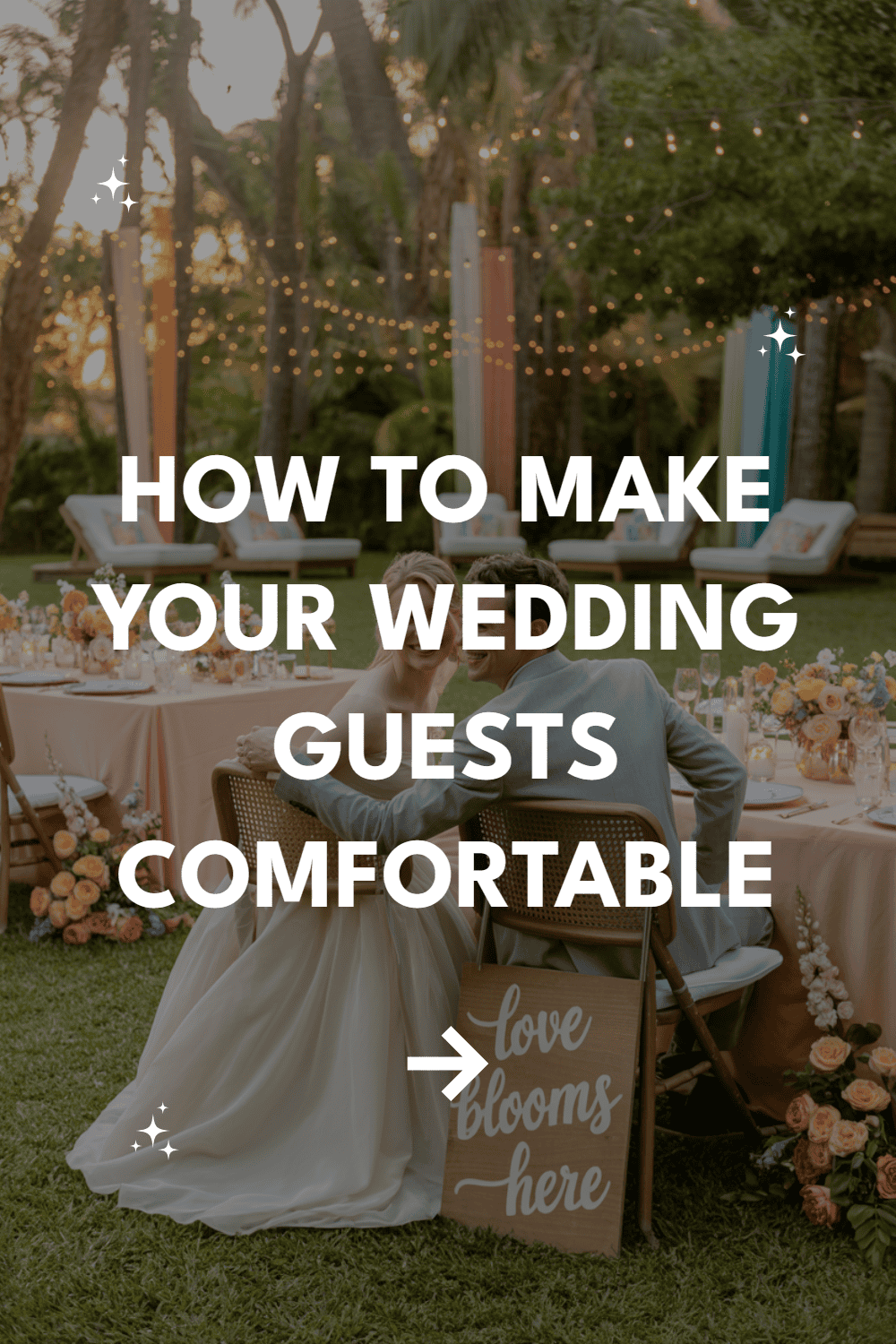Your guests are showing up to celebrate you, often traveling long distances and spending their hard-earned money on outfits they’ll wear once. The least you can do is make sure they’re not miserable while they’re there.
Think Like a Host, Not a Bride
Wedding planning can turn even the most considerate people into self-absorbed monsters. You’ll catch yourself obsessing over centerpiece heights while completely forgetting that Aunt Margaret has a bad hip and can’t stand for two hours during cocktail hour.
Step back from the Pinterest boards for a hot minute. Ask yourself: if you were attending this wedding as a guest, what would make you feel welcomed versus what would make you want to fake a migraine and leave early?
The best weddings feel like the couple actually wants their guests there, not like they’re just pretty props for photos.
Your job is to create an experience where people feel cared for, not like they’re enduring some elaborate performance art piece about your love story.
The Comfort Basics That Actually Matter
Seating That Makes Sense
Nobody wants to play musical chairs at your wedding. Create a seating chart that considers actual relationships, not just how the tables look in your floor plan diagram.
Put the extroverts with other extroverts, seat the parents’ friends together, and for the love of all that’s holy, don’t stick your single friends at the “singles table” like they’re damaged goods.
Mix couples and singles thoughtfully—some married people are boring, and some single people are the life of the party.
Consider physical needs too. Great-aunt Helen shouldn’t be seated at the table farthest from the bathroom, and your friend who’s eight months pregnant needs easy access to everything.
Temperature Control Reality Check
Outdoor weddings in July sound romantic until your guests are sweating through their formal wear while you’re getting perfect sunset photos. If you’re set on an outdoor celebration, acknowledge that comfort trumps aesthetics.
Provide fans, pashminas, or heaters depending on the season. Set up a hydration station that’s actually accessible, not hidden behind the gift table where nobody can find it.
Indoor venues aren’t immune either. A room packed with 150 people gets hot fast, especially when everyone’s dancing. Talk to your venue about climate control before the day arrives.
Food and Drink Strategy
Timing That Doesn’t Torture People
The biggest guest comfort killer? Poor timeline management that leaves people hangry and confused. If your ceremony starts at 4 PM and dinner isn’t until 8 PM, you better have substantial cocktail hour food.
Don’t serve three sad pieces of cheese and call it cocktail hour. People need actual sustenance, especially if they’ve been drinking. Think sliders, substantial appetizers, or a proper cocktail hour spread.
Late-night snacks aren’t just trendy—they’re necessary if you want people to stick around and actually enjoy themselves instead of sneaking out to hit a drive-through.
Dietary Needs Without the Drama
Food allergies and dietary restrictions aren’t personal attacks on your menu vision. They’re reality, and ignoring them makes you look thoughtless.
Include dietary preference options on your RSVP cards and actually follow through. Having one sad vegetarian option that looks like punishment food doesn’t count as accommodation.
Work with your caterer to create alternatives that don’t make people feel like second-class citizens. A well-executed vegetarian dish can be just as impressive as the beef tenderloin.
Communication That Actually Helps
Wedding Websites That Work
Your wedding website shouldn’t require a PhD to navigate. Include the information people actually need: parking details, hotel recommendations with actual prices, and a realistic timeline of events.
Skip the novel-length love story that nobody asked to read. Save that energy for practical details like whether the ceremony is outdoors (hint: people need to know what shoes to wear) and if kids are welcome.
Update the website when things change. Your guests shouldn’t find out about a venue change through Instagram stories.
Clear Expectations From the Start
Mixed messages about dress code, plus-ones, and children create anxiety and resentment. Be direct about what you want instead of hoping people will read your mind.
“Cocktail attire” means something specific. “Dressy casual” is meaningless. Give people actual guidance they can work with, especially if your venue has specific requirements like no stilettos on the lawn.
Address the elephant in the room upfront. If it’s an adults-only celebration, say so clearly and kindly. If you can’t afford to give everyone a plus-one, that’s understandable, but be consistent about who gets one.
The Physical Comfort Details
Weather Contingency Plans
Mother Nature doesn’t care about your wedding vision. Having a backup plan shows you care more about your guests’ comfort than your Instagram aesthetic.
Tents aren’t just for rain—they provide shade and create defined spaces that feel more intimate than a wide-open field. Invest in sidewalls if there’s any chance of wind or temperature drops.
Communicate weather plans clearly. Guests need to know if they should bring umbrellas or if you’ve got it covered.
Bathroom Accessibility
This isn’t glamorous, but bathroom logistics can make or break guest comfort. If your venue has limited facilities, rent additional ones that don’t look like construction site porta-potties.
Consider the logistics of your guest list. Older guests and pregnant women need closer access. Long dresses and bathroom stalls don’t mix well, so think about spacing and accessibility.
Stock bathrooms with basics: decent toilet paper, hand soap, and maybe some emergency supplies like stain remover or safety pins. Your guests will remember these thoughtful touches.
Entertainment and Flow
Music Volume Sanity
Your wedding playlist is fire, but if people can’t have conversations without shouting, you’ve lost the plot. Good music enhances the atmosphere; it doesn’t dominate it.
Different parts of your wedding need different energy levels. Cocktail hour music should encourage mingling, not overwhelm it. Save the dance floor bangers for when people are actually ready to dance.
Consider your guest demographics. If half your guests are over 60, maybe ease up on the bass-heavy hip-hop during dinner.
Activity Balance
Not everyone wants to dance, and that’s okay. Create spaces where different personality types can be comfortable throughout the evening.
Cocktail hour should offer activities beyond standing around with drinks. Lawn games, a photo booth, or even just well-arranged seating areas give people options for how to engage.
Don’t pack your timeline so tightly that guests feel rushed from one activity to the next. People need breathing room to actually enjoy themselves.
Managing Special Circumstances
Guest Accommodations
Out-of-town guests need more than a list of nearby hotels. Research actual availability and pricing, especially if your wedding is during peak season or in a small town with limited options.
Negotiate group rates when possible, but don’t assume the cheapest option is the best. Your guests’ comfort is worth the extra effort to find decent accommodations.
Provide transportation information that’s actually useful. “It’s about 20 minutes away” doesn’t help someone who doesn’t know the area and is trying to coordinate ride shares.
Family Dynamics and Seating Politics
Every family has drama, and your wedding day isn’t when it magically disappears. Plan seating with realistic expectations about who can and can’t be near each other.
Don’t try to force reconciliations through strategic seating. Put the divorced parents at separate tables with their respective support systems. Everyone will be more comfortable.
Brief your wedding party and close family about any sensitive situations. They can help redirect conversations or provide buffers when needed.
Final Touches That Show You Care
Small gestures make a big impact on guest comfort. A basket of flip-flops for dancing, welcome bags with local treats, or a coat check area shows thoughtfulness without breaking the budget.
Consider the practical needs of your specific guest list. If you have elderly relatives attending, ensure there are comfortable seating options throughout the venue. If kids are invited despite your initial hesitation, have some activities ready to keep them occupied.
Creating Lasting Comfort
The most comfortable weddings feel effortless because the couple planned for their guests’ needs, not just their own vision. When people feel welcomed and cared for, they relax and genuinely celebrate with you.
Your guests will forget the exact shade of your bridesmaid dresses, but they’ll remember how you made them feel. Prioritize their comfort, and you’ll create the kind of wedding people actually want to attend—and stay at until the very end.


